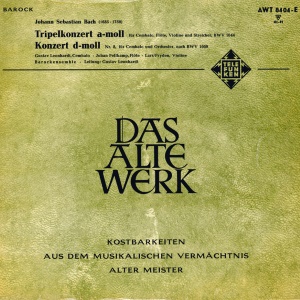 |
1 LP
10" - AWT 8404-E - (p) 1955
|
|
Johann Sebastian
Bach (1685-1750)
|
|
|
|
|
|
|
|
| Konzert d-moll für
Cembalo und Orchester - nach BWV
1059 (wiederhergestellt von Gustav
Leonhardt) |
|
10' 54" |
|
| - Allegro |
5' 59" |
|
A1 |
| - Adagio ad libitum |
1' 15" |
|
A2 |
- Presto
|
3' 40" |
|
A3 |
|
|
|
|
| Tripelkonzert a-moll für
Cembalo, Flöte, Violine und Streicher,
BWV 1044 |
|
21' 53" |
|
- Allegro
|
8' 28" |
|
A4 |
| - Adagio ma non tanto e
dolce |
6' 21" |
|
B1 |
| - Alla breve |
7' 04" |
|
B2 |
|
|
|
|
| Barockensemble
/ Gustav Leonhardt, Leitung |
|
|
| -
Marie Leonhardt, Violine und
Bratsche |
Gustav
Leonhardt, Cembalo (Robert
Globe, Oxford, 1949)
|
|
| -
Antoinette van den Hombergh,
Violine |
Johan
Feltkamp, Flöte |
|
| -
Wim ten Have, Bratsche |
Lars
Frydén, Violine |
|
| -
Nikolaus Harnoncourt, Violoncello |
|
|
| -
Fred Nijenhuis, Kontrabaß |
|
|
| -
Cees van der Kraan, Oboe |
|
|
|
Luogo e data
di registrazione
|
| 1955 |
|
Registrazione
live / studio
|
| studio |
Producer / Engineer
|
-
|
Prima Edizione
CD
|
-
|
Prima
Edizione LP
|
Telefunken "Das Alte Werk" -
AWT 8404-E - (1 lp 10") - 32' 47" - (p)
1955 (rec)
|
|
|
Notes
|
In
the baroque period it was
quite a common practice to
rearrange works by other
composers. Most of Bach's
harpsichord concertos are
arrangements of concertos by
other masters (Vivaldi,
Marcello etc.) or of works
on his own wich were not
even composed in concerto
form in the firs place.
Thus for example the first
and the third movement of
the Triple Concerto have
been formed - with a few
alterations to suit the new
medium - from the Prelude
and Fugue in A minor for
keyboard (BWV 894). In the
second movement, on the
other hand, the three solo
instruments play almost note
for the middle section of
the Trio Sonata in D minor
for Organ (BWV 527),
transposed into C major.
As regards the Harpsichord
Concerto No. 8, only the
first nine bars, i. e. the
opening tutti, were worked
out by Bach (BWV 1059). All
the rest has been highly
successfully reconstructed
by Gustav Leonhardt, a
harpsichordist and
musicologist of
international repute on
account of his performance
of baroque music, with an
extraordinary feeling for
Bach's method of
arrangement. The first nine
bars seem to be a version of
the opening of the first
Sinfonia (for organ, strings
and three oboes) to Cantata
No. 35. This served as a
pattern for the first
movement of the restored
concerto, for which Bach had
required "Cembalo solo, una
Oboe, due Violini, Viola e
Cont.". The thematic
material differing from this
in the first nine bars has,
also been incorporated into
the original organ part,
entirely on the model Bach
has provided with the
"harpsichordizing" of other
works. It is also as good as
certain that the other
Sinfonia of the same cantata
was to have become the last
movement of our concerto.
The orchestral parts have
been taken over almost
unchanged and the
harpsichord part adapted to
suit the instrument. The
slow middle movement must,
however, be regarded as
lost. In order not to have
to dare composing a complete
imitation "Bachian"
movement, Leonhardt has
followed the example set by
Bach himself in his Thrird
Brandenburg Concerto. There
he has only written two
cadenza chords, everything
else being left to the
performer. In the same way a
short improvisation leads
into the last movement of
this harpsichord concerto.
String Instruments in
baroque dimensions: thinner
bass bar, less slanting
neck, thicker bridge. Gut
strings, only lowest
covered. Specific baroque
tone-colour, of sonorous
clarity.
Harpsichord on historical
model with raven quill
jacks. Pitch: German
"kammerton" of the 18th
century, nearly a semitone
below, modern pitch.
Dr.
G.G. (transl.: D.G.E.)
|
|
Nikolaus
Harnoncourt (1929-2016)
|

|

|
|